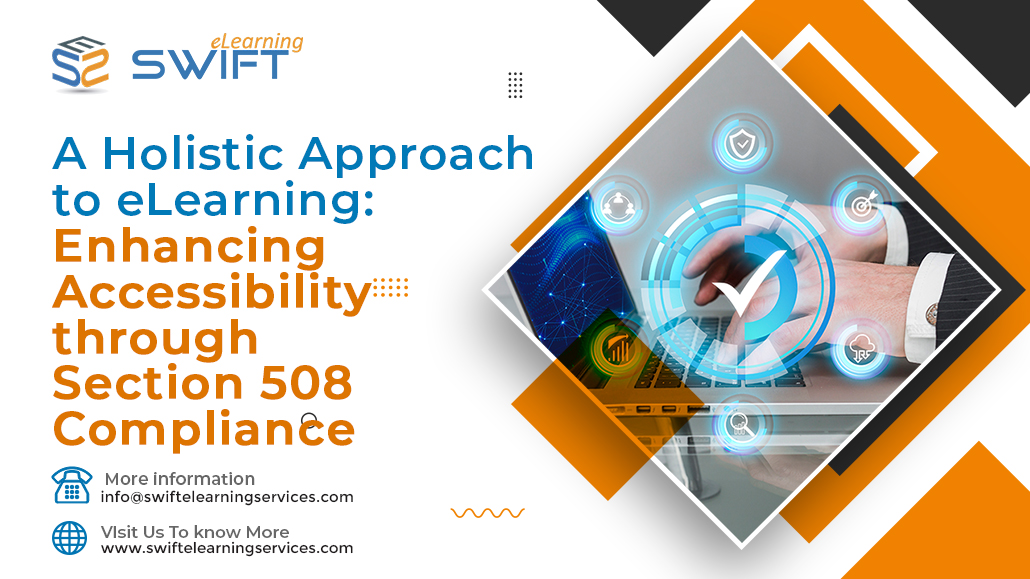A Holistic Approach to eLearning: Enhancing Accessibility through Section 508 Compliance
Discover the significance of a holistic approach to eLearning through Section 508 compliance. Learn how enhancing accessibility benefits learners, the key requirements, and the future trends in creating an inclusive digital education environment.
In the rapidly evolving landscape of education, eLearning has emerged as a transformative force, offering flexibility, convenience, and personalized learning experiences. However, as we embrace the digital realm, it is imperative to ensure that educational platforms are accessible to all individuals, including those with disabilities. This is where Section 508 compliance comes into play.
In this blog post, we will delve into the importance of a holistic approach to eLearning that focuses on enhancing accessibility through Section 508 compliance.
1. Understanding Section 508 Compliance
Section 508 is a part of the Rehabilitation Act of 1973, and it mandates that all electronic and information technology developed, procured, maintained, or used by federal agencies must be accessible to individuals with disabilities. While the primary audience for Section 508 is the federal government, its principles have far-reaching implications, particularly in the eLearning sector.
2. Key Requirements of Section 508
2.1 Web-based Intranet and Internet Information Systems
Section 508 requires that web-based content be accessible. This includes websites, online courses, and other digital resources commonly used in eLearning platforms.
2.2 Multimedia Content
Multimedia elements such as videos and audio files must have captions, transcripts, and alternative formats to ensure individuals with hearing or visual impairments can access the content.
2.3 Non-Text Content
Images, graphics, and other non-text elements must be accompanied by descriptive text or alternative descriptions, allowing screen readers to convey the information to visually impaired users.
2.4 Navigation and Keyboard Accessibility
ELearning platforms should be navigable using keyboard commands alone, ensuring that individuals who cannot use a mouse due to mobility impairments can still interact with the content effectively.
2.5 Readable Fonts and Colors
Text should be easily readable, and color choices should take into account individuals with color blindness or other visual impairments.
2.6 Adaptive Technologies Compatibility
ELearning content and platforms should be compatible with adaptive technologies such as screen readers, voice recognition software, and other assistive devices.
3. Benefits of Section 508 Compliance in eLearning
Ensuring Section 508 compliance in eLearning brings forth a multitude of benefits that not only enhance accessibility but also contribute to the overall effectiveness and inclusivity of the learning experience. Here are 15 significant advantages of adhering to Section 508 standards in eLearning:
3.1 Inclusivity
By adhering to Section 508 compliance standards, eLearning platforms become more inclusive, welcoming learners of all abilities. This fosters a diverse and enriched learning environment.
3.2 Equal Access to Education
Compliance guarantees that individuals with disabilities have the same educational opportunities as their peers, eliminating barriers to learning.
3.3 Legal and Ethical Responsibility
Beyond the moral imperative of accessibility, there are legal obligations to make educational content accessible. Non-compliance could lead to legal challenges and reputational damage.
3.4 Expanded Reach
Accessible eLearning platforms cater to a broader audience, including individuals with disabilities who might otherwise be excluded from traditional learning settings.
3.5 User-Centric Design
Prioritizing accessibility often leads to better user experience for all learners. Clearer navigation, organized content, and adaptable formats benefit everyone.
3.6 Innovation through Constraints
Designing for accessibility encourages creative problem-solving. Constraints posed by accessibility requirements can spark innovation in content delivery.
3.7 Positive Institutional Reputation
Institutions that prioritize accessibility through Section 508 compliance showcase their dedication to social responsibility, bolstering their reputation within the education sector.
3.8 Better Learning Outcomes
Accessible content ensures that all learners can engage effectively, leading to improved learning outcomes and student success.
3.9 Professional Development
Compliance necessitates ongoing training for educators and content creators, fostering continuous improvement and professional development in the field of accessible design.
3.10 Adaptable Learning Environment
Accessibility features, such as alternative content formats and adjustable interfaces, enable learners to tailor the learning environment to their individual preferences.
3.11 Enhanced Cognitive Engagement
Accessible design often involves simplifying complex concepts, benefiting all learners by making the content more digestible and engaging.
3.12 Preparedness for Technological Advancements
As technology evolves, Section 508 compliance ensures that eLearning platforms can seamlessly integrate new tools and functionalities while maintaining accessibility.
3.13 Compliance with Industry Standards
Many education systems and organizations require compliance with accessibility standards, ensuring that eLearning platforms remain aligned with broader educational trends.
3.14 Engagement with Accessibility Community
Embracing Section 508 compliance fosters connections with the broader accessibility community, providing valuable insights and best practices.
3.15 Long-Term Cost Savings
Investing in accessibility from the outset reduces the need for retroactive modifications, saving both time and resources in the long run.
Section 508 compliance in eLearning offers far-reaching benefits that extend beyond mere accessibility. It supports equal opportunity, enhances learning experiences, and positions educational institutions as leaders in creating inclusive, innovative, and effective digital learning environments.
4. Implementing a Holistic Approach
4.1 Designing Accessible Content
Content creators should adopt practices such as using descriptive alt text for images, providing well-structured headings, and ensuring proper contrast between text and background.
4.2 Responsive Design
ELearning platforms must be responsive to various devices and screen sizes, ensuring that content is legible and navigable on both desktops and mobile devices.
4.3 Captioning and Transcription Services
Utilize reliable captioning and transcription services for multimedia content. This not only aids individuals with disabilities but also benefits non-native speakers and learners in noisy environments.
4.4 Regular Audits and Testing
Conduct frequent accessibility audits and usability testing to identify and rectify any accessibility issues promptly. This iterative process ensures ongoing compliance.
4.5 Training and Awareness
Educate content creators, designers, and developers about the importance of accessibility and provide training on how to implement accessibility features effectively.
4.6 Collaboration with Accessibility Experts
In-depth collaboration with accessibility experts during the development phase can pre-emptively address potential issues and lead to more seamless integration of accessibility features.
5. Challenges and Future Trends
While the journey toward full accessibility in eLearning is commendable, challenges remain. Some challenges include the need for continuous updates to meet evolving accessibility standards, the cost of implementing accessibility features, and the misconception that accessible design compromises aesthetics.
Looking ahead, trends such as AI-driven accessibility solutions, increased focus on cognitive accessibility, and a global shift towards inclusive design are expected to shape the future of accessible eLearning.
6. Conclusion
A holistic approach to eLearning, guided by the principles of Section 508 compliance, not only ensures that digital education is accessible to all individuals but also promotes innovation, inclusivity, and equal opportunity. As technology continues to reshape education, it is our responsibility to ensure that nobody is left behind. Through the implementation of accessible design, we can create a future of learning that truly leaves no one out.
Frequently Asked Questions (FAQs)
What is Section 508 compliance?
Section 508 compliance refers to the legal requirement that electronic and information technology developed, used, or procured by federal agencies be accessible to individuals with disabilities. This principle has a broader impact on various sectors, including eLearning.
Why is Section 508 compliance important in eLearning?
Section 508 compliance ensures that eLearning platforms and content are accessible to all learners, regardless of their disabilities. This inclusivity fosters a diverse learning environment, expands the reach of education, and fulfils legal obligations.
What are the key requirements of Section 508 in eLearning?
Section 508 mandates accessible web-based content, multimedia with captions and transcripts, non-text content descriptions, keyboard navigation, readable fonts and colors, and compatibility with adaptive technologies.
How does Section 508 compliance benefit eLearning?
Section 508 compliance makes eLearning platforms more inclusive, legally responsible, and user-friendly. It expands the potential audience, promotes innovative design, and ensures a better learning experience for everyone.
What is a holistic approach to eLearning accessibility?
A holistic approach involves designing accessible content, utilizing responsive design, captioning and transcribing multimedia, conducting regular audits, providing training, and collaborating with accessibility experts to ensure comprehensive accessibility.
What challenges are associated with eLearning accessibility?
Challenges include the need for continuous updates, cost considerations, and the misconception that accessible design compromises aesthetics. However, these challenges can be overcome with careful planning and commitment.










Leave a Reply
Want to join the discussion?Feel free to contribute!